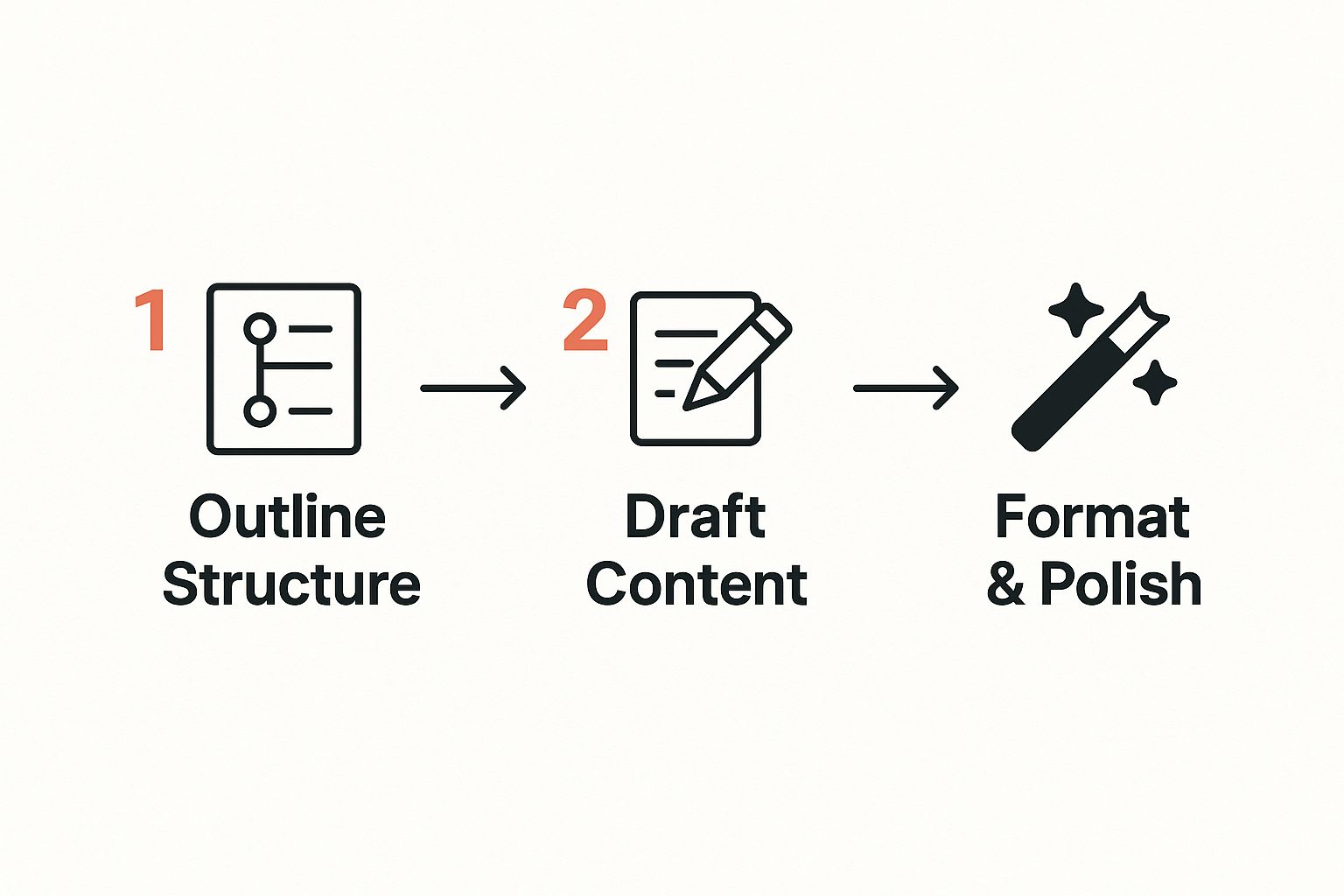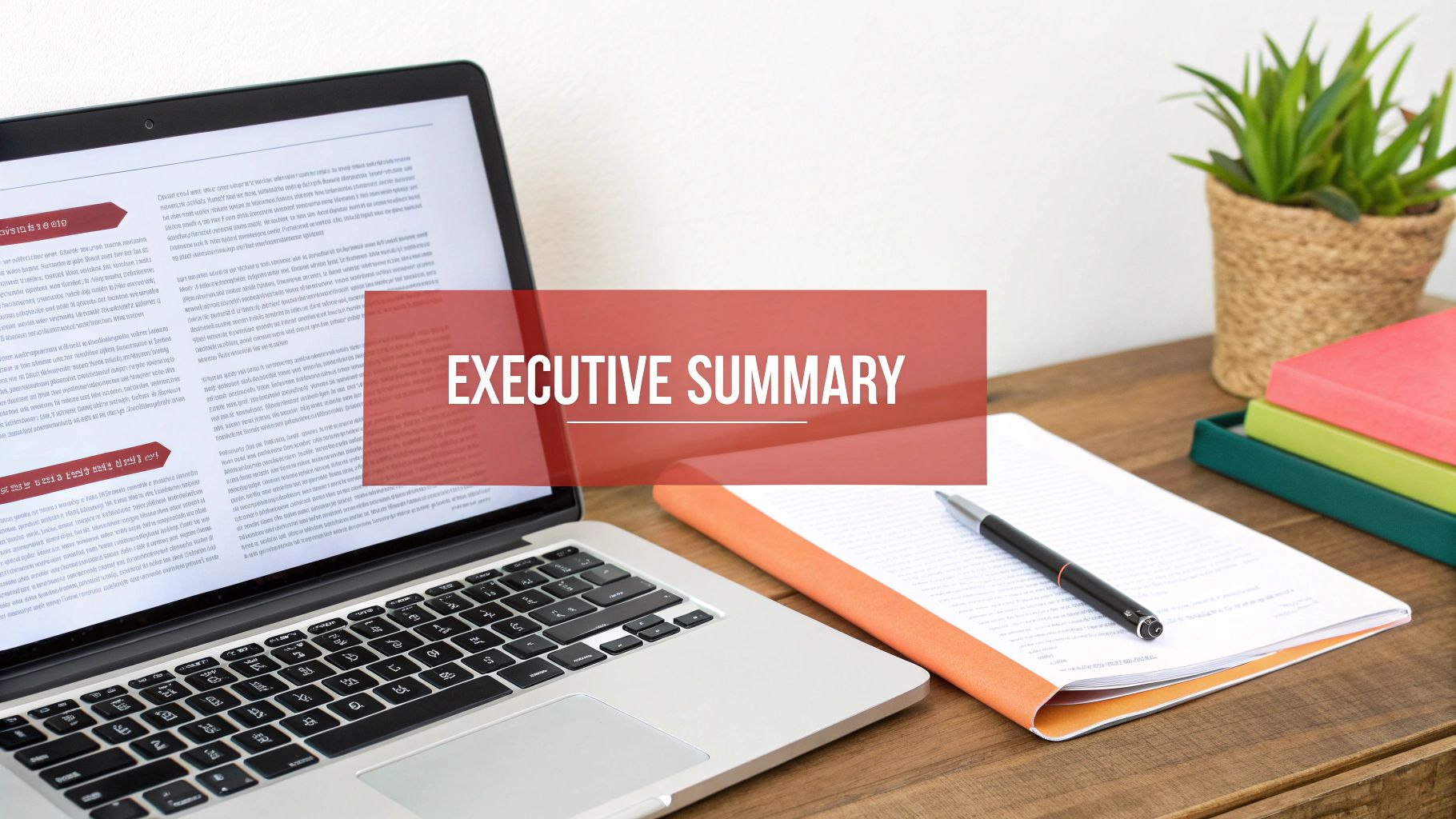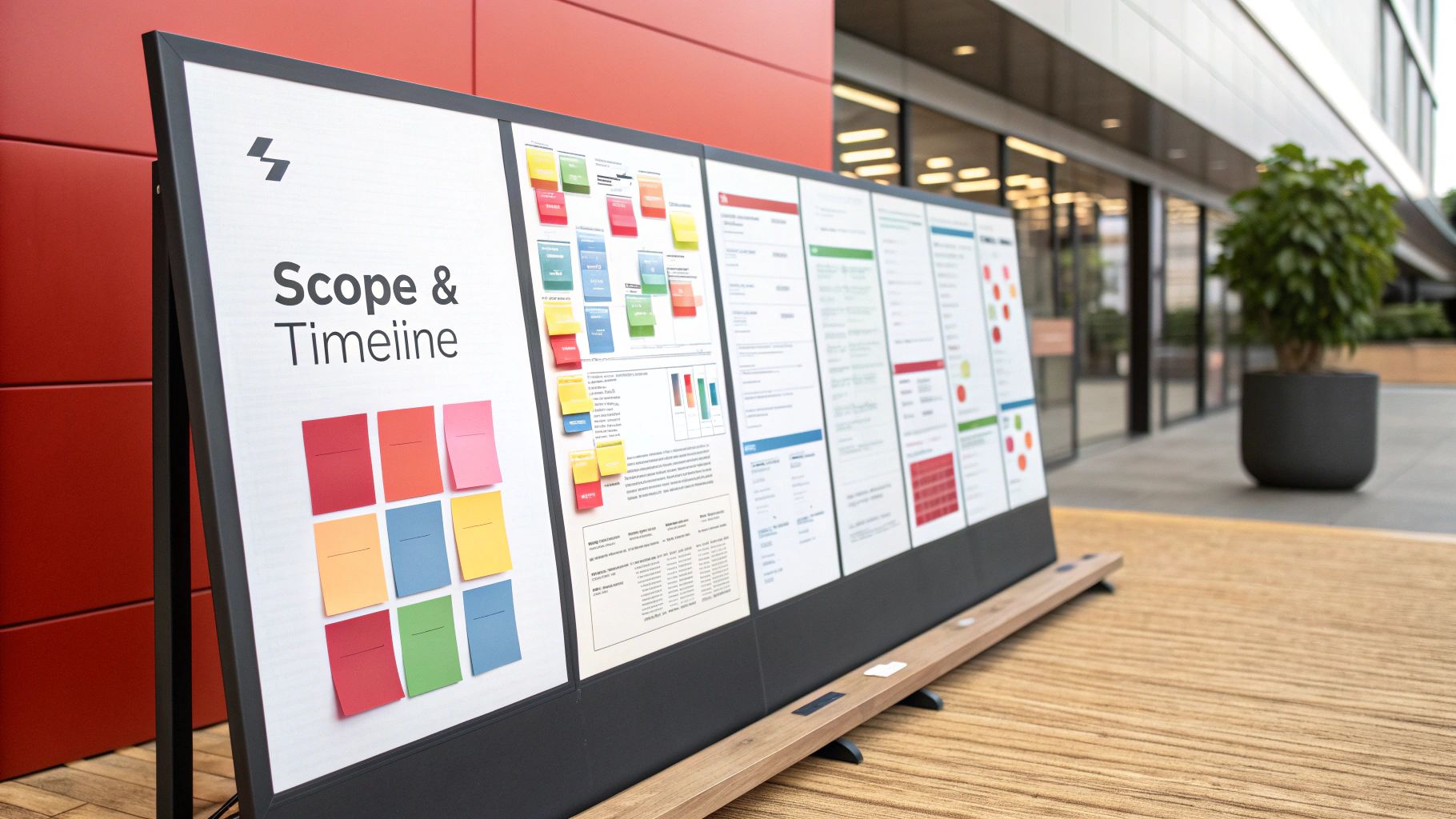When you boil it down, knowing how to create a great proposal comes down to a single, powerful idea: it’s not about you, it’s about solving the client’s problem. A winning proposal isn't just a document; it's a strategic argument that clearly diagnoses a client’s pain points, presents your agency as the specific solution, and outlines the tangible results you'll deliver.
What a Modern Agency Proposal Looks Like in 2024
Forget the generic, one-size-fits-all templates from a few years ago. Today's agency proposal is a deeply strategic, client-focused tool that does more than just list services—it sells a solution. Think of it as your first real demonstration of expertise, showing the client you understand their world before asking them to invest in yours.
This approach means shifting your entire focus from "Here's what we do" to "Here's what we'll achieve for you." The proposals that actually get signed are always built on a foundation of genuine client insight.
The goal isn’t just to win the project; it’s to start a partnership. Your proposal should feel like the first step in a collaborative journey, making it easy for the client to see your agency as an extension of their team.
Why Hyper-Personalization is the New Standard for Agencies
Client expectations have evolved. They don’t want a brochure; they want a business case tailored specifically to their unique challenges and goals. Sending a generic proposal signals a lack of effort, and frankly, it just doesn't work anymore.
This is where hyper-personalization becomes your secret weapon. We're also seeing technology play a much bigger role in this shift. Early adopters of generative AI for competitive research have already hit 37%, and a whopping 46% of RFP teams are optimistic about using AI for proposal creation. This isn't just a fad; it's a clear trend toward using smarter tools to craft more precise, data-driven proposals that truly resonate with what a client needs. If you're curious, you can discover more about the future of proposal writing and how to stay ahead.
A modern proposal is dynamic. It hooks the reader with a compelling executive summary, sets clear expectations with a detailed scope of work, and uses transparent, value-based pricing that frames your services as an investment, not just another expense. Once you master these elements, you position your agency as the obvious partner from the very first page.
Before we dive into the nitty-gritty of each section, let's get a high-level view of what a truly effective proposal contains. This table breaks down the essential components that should be in every single proposal you send.
The 7 Key Components of a Winning Agency Proposal
Think of this table as your pre-flight checklist. Missing any of these pieces can create friction and doubt, making it harder for a client to say "yes." Now, let's get into how to build each of these sections out.
Step 1: Winning the Deal Before You Write a Word (The Discovery Phase)
Let's be honest. The best proposals aren't won with fancy designs or perfectly polished copy. They’re won long before you even open a document, during what we call the discovery phase.
This is the crucial pre-writing work that separates agencies that consistently land clients from those who always end up in the "no" pile. Skipping this step is like a contractor trying to build a house without a blueprint. Sure, you might end up with something, but it definitely won't be what the client actually wanted or needed.
Your main goal here is to get past the client’s initial request and dig up the real, underlying business challenges they're facing. A prospect might come to you asking for a new website, but what they truly need is to boost online sales by 25% to fend off a new competitor. A winning proposal tackles the business goal, not just the technical to-do list.

Uncovering the Client's Real Needs with Strategic Questions
So, how do you get to that juicy, strategic insight? It all starts with asking better questions. Instead of just taking a client's brief at face value, you have to dig deeper to understand the "why" behind their request. A client asking for a "social media campaign" is just the starting point, not the destination.
Your discovery call is where you uncover the context your competitors will almost certainly miss. Here are a few questions that get right to the heart of the matter:
- What specific business outcome are you hoping this project achieves?
- What does success look like for you in six months? What metrics will we be tracking?
- What have you already tried to solve this problem, and what were the results?
- Who are the key decision-makers involved, and what does each of them care about most?
Questions like these completely change the game. You're no longer just another vendor quoting a price; you're a strategic partner. This foundational work also sets the stage for genuine collaboration. Honing your questioning and listening skills is a career-long process, but mastering the basics of client communication best practices is absolutely essential for gathering the insights needed to build a proposal they can't refuse.
Pro Tip: Don't stop your research after the discovery call. Dive into their competitors' strategies, read their own case studies, and even check out their key employees on LinkedIn. It shows you've put in the time and are genuinely invested in seeing them win.
Turning Raw Client Insight into a Winning Agency Strategy
Once you've collected all this intelligence, you can start weaving a story that connects directly with the client's world. You’re no longer just listing services and deliverables; you're presenting a custom-built solution to a problem you now understand inside and out. This is how you create a proposal that feels like it was made just for them—because it was.
For instance, say your research uncovers that their biggest competitor just rolled out a massively successful loyalty program. Suddenly, your proposal for a "website redesign" can include a specific recommendation for a customer rewards system, directly countering a competitive threat the client might not have even mentioned. That kind of proactive thinking shows immense value before you’ve even signed a contract.
While agency proposals have their own flavor, the core idea of deeply understanding your audience's needs is universal. For a great primer on these fundamentals in a different field, check out a guide like grant writing for dummies, which also hammers home the importance of building a compelling case on a foundation of solid research. This groundwork is what turns your proposal from just another document into the clear, obvious solution to their problem.
Step 2: Structuring Your Agency Proposal for Maximum Impact
You’ve done the hard work during discovery and now you're sitting on a pile of gold—all the raw intelligence you need to make a winning argument. The next step is critical: assembling that intelligence into a proposal that doesn't just inform, but persuades. It needs to guide your prospect logically and emotionally toward a "yes."
How you organize your proposal is just as important as what's in it. A confusing or jumbled document creates friction and doubt. But a well-structured one? It makes it dead simple for your stakeholders to see the value and become your biggest fans inside their own company.
Think of it like you're building a case in a courtroom. You don't lead with minor details. You open with a powerful statement, lay out the evidence, and build to an undeniable conclusion. For an agency, this means you start with their problem, not your company history.
A great proposal structure doesn't just present information; it builds momentum. Each section should flow seamlessly into the next, answering the client's questions before they even have to ask them.
Hook Them Fast: Crafting the Executive Summary and Problem Statement
The first page is your most valuable real estate. You have one shot to hook them, and it starts with an executive summary that proves you were actually listening.
This isn’t a long, meandering intro. It’s a crisp, one-page snapshot of their key challenge, your proposed solution, and the exact outcome you'll deliver. It needs to be clear enough for a busy CEO to scan and immediately grasp the project's entire value proposition.
Right after that, you need to nail the problem statement. This is where all your discovery work pays off. Frame their pain points clearly, and if you can, use their own words. Show them you truly get what's at stake—not just that they need "a new marketing campaign," but that their current lead generation is stalling, costing them 20% market share to a nimbler competitor. This section validates their concerns and instantly positions you as an expert who's already diagnosed the root issue.
From Problem to Plan: Detailing Your Solution and Scope of Work
Once the client feels understood, they're ready to hear your plan. This is where you lay out how you’re going to solve their problem. Resist the urge to just list generic services. Instead, tie every single activity directly to their goals.
- Strategy: Give them the high-level approach. Are you going all-in on SEO to build a long-term organic moat, or are you launching a paid social blitz to get leads in the door yesterday? Explain the "why" behind your choice.
- Deliverables: Get specific about the tangible things they'll receive. This isn't just "content marketing"; it's a 12-month content calendar, four 1,500-word blog posts per month, and a monthly performance report.
- Timeline: Lay out a realistic project timeline with key milestones. This manages expectations from day one and shows you have a concrete, actionable plan.
This is also where you need a meticulously defined scope of work. Be crystal clear about what's included and—just as importantly—what's not. This simple act of clarity is your best defense against scope creep and lays the groundwork for a healthy, drama-free relationship.
Justifying the Investment and Proving Your Agency is the Right Team
Finally, it’s time to talk money and convince them you're the right crew for the job. When it comes to pricing, don't just slap a number on the page and hope for the best. You need to frame it as an investment.
If you can, offer 2-3 tiered packages. This brilliantly shifts the conversation from "if" to "which." More importantly, connect every dollar back to the value you're delivering. Show them the math.
This is also the perfect spot to sprinkle in social proof. A well-placed case study about a company that faced the exact same challenge can be incredibly persuasive. Follow that up with short, engaging bios of the key people who will be working on their account. It adds a human touch and gives them confidence that they’ll be in capable hands.
Your whole structure should build to one final, logical point: a clear call to action that tells them exactly what to do next to get started.
Step 3: Writing Compelling Proposal Content That Converts Clients
So, you've got the skeleton of your proposal mapped out. That's a great start, but now comes the part that really does the heavy lifting: the words themselves. It doesn't matter how brilliant your strategy is if the writing falls flat. A great idea wrapped in clumsy language is just another document a client will skim and promptly forget.
This is where you learn to write copy that speaks directly to your client’s world, in a voice that’s clear, confident, and persuasive.
The most critical shift you can make is to stop talking about yourself and start talking about them. It’s a subtle change, but it changes everything. Instead of listing what you do, focus on what they get.
- We offer advanced SEO services. (This is all about your agency.)
- You'll achieve top search rankings, driving more qualified leads right to your website. (This is all about their success.)
See the difference? That simple flip reframes your entire value proposition. You’re no longer just selling a service; you're selling a specific, desirable outcome.
To get there, I like to follow a simple workflow for drafting and polishing proposal content.

This process ensures you’re building on a solid foundation, keeping the client at the center, and adding that final layer of polish that makes your proposal feel truly professional.
Writing a Winning Executive Summary: The One-Page Pitch
The executive summary is, without a doubt, the most important page in your entire proposal. We talked about where it goes in the last section, but the content itself needs to be sharp enough to sell the whole project on its own.
Think about it: a busy decision-maker might only read this one page. It has to be a powerful, bite-sized narrative that lays out their core problem, your proposed solution, and the incredible results they can expect. It’s the trailer to your movie—it has to be compelling enough to make them want to see the whole thing.
For a deeper look into making that first impression count, it’s worth understanding the core principles of how to write an objective summary. Many of the same rules about clarity and impact apply here.
Here's a pro tip: always write the executive summary last. Once you’ve hammered out all the details—the solution, the scope, the timeline, the pricing—you'll have a much clearer picture of the project's total value. This allows you to summarize it with way more impact and precision.
How to Translate Agency Features into Client-Centric Benefits
Clients don’t buy features; they buy what those features will do for them. This is one of the biggest and most common mistakes I see agencies make. They just list their services without ever connecting them to real-world business outcomes.
Your prospect doesn’t actually care about your "proprietary content framework." They care that your framework will double their website traffic and generate more sales.
To sidestep this trap, I use a simple "Feature-to-Benefit" translation for every single thing we offer.
This exercise forces you to think from the client's perspective. It shows you understand their world and proves you're focused on their success, not just on checking off a list of tasks. This is how you make hiring your agency feel less like a choice and more like the obvious solution to their problem.
Step 4: Using Technology to Streamline Your Agency's Proposal Creation Process

In a competitive agency world, efficiency isn't just a buzzword—it's your secret weapon. If you're still building every proposal from scratch, you're not just moving slowly. You're actively burning through your team's most valuable asset: their time for strategic thinking.
Let's be clear. The goal here isn't to automate the human touch out of existence. It's to kill the tedious, repetitive tasks that get in the way of it. When your team isn't wrestling with formatting or digging through old folders for the perfect case study, they can zero in on what actually closes deals: deeply understanding the client's problems.
This isn't just a hunch. Sales pros spend only about 36% of their day actually selling. The rest gets eaten up by admin work, with proposal drafting being a major culprit. You can see the full research on proposal management and sales productivity for the hard numbers. The right tech stack is how you reclaim that lost time.
How Proposal Creation Time Impacts Your Agency's Win Rate
Spending more time on a proposal doesn't always lead to a better outcome. In fact, a streamlined, efficient process often correlates with higher win rates because it allows for more personalization and faster response times. Here's a look at how different agency teams fare:
The data is pretty clear: efficiency pays off. Smart automation doesn't just save time; it directly contributes to a healthier bottom line by improving your chances of winning.
Using Proposal Management Software for Brand Consistency
For an agency, consistency is credibility. A proposal that goes out with an old logo or an outdated service description looks unprofessional. It signals that you don't have your own house in order.
This is exactly the problem that modern proposal management software is built to solve. Think of it as a central command center for all your sales documents.
- Rock-Solid Brand Consistency: You can lock down templates to make sure every single proposal uses the right branding, fonts, and core messaging. No more rogue documents.
- Ready-to-Go Content Libraries: Store your pre-approved case studies, team bios, and service descriptions. Your team can pull in accurate, up-to-date content in seconds.
- Frictionless Team Collaboration: Multiple people can jump into a proposal, track changes, and get approvals without the nightmare of endless email chains.
This approach creates a process that can actually scale. When you hire someone new, you can get them up to speed fast, knowing they’re using the best, most effective materials from day one.
The real magic of proposal software is turning your best content into reusable assets. That killer case study or perfectly worded value prop can be deployed instantly across multiple deals, maximizing its impact.
How Agencies Can Use AI to Handle the First Draft
Artificial intelligence isn't some far-off concept anymore; it's a practical, everyday tool for sharp agencies. Used smartly, AI can be an incredibly powerful assistant, freeing up your team for the kind of high-level thinking that computers can't replicate.
AI-powered tools can handle the initial grunt work—summarizing discovery call notes, checking for grammar, and even spinning up a rough first draft. This doesn't replace your strategists. It augments them. It hands them a solid starting point so they can jump straight into refining, personalizing, and injecting real human insight. For a deep dive on how to integrate these tools, check out our guide on AI for agencies.
Think of AI as a really fast, slightly naive junior copywriter. It's great for getting the basic structure down, but the final polish, the strategic nuance, and the client-centric messaging? That has to come from your experienced team. This balanced approach is a massive advantage in today's fast-moving market.
Step 5: The Final Polish: From Design to Client Follow-Up

It's a classic agency blunder: pouring dozens of hours into discovery, strategy, and copywriting, only to stumble right before the finish line. A brilliant strategy can be completely undermined by a sloppy presentation.
The final steps—polishing the design and nailing the follow-up—are what actually get your proposal signed. This is where you make sure all that hard work gets the serious consideration it deserves.
Think of your proposal's design as a functional part of your argument, not just decoration. Great design makes your proposal a breeze to read and digest, guiding the client's eye exactly where you want it to go. It quietly communicates professionalism and an obsession with detail—two things every client is looking for in a partner.
Using Smart Design to Improve Readability and Professionalism
Your proposal's look and feel should amplify your message, not distract from it. The goal here is clarity and a professional touch. A clean layout with plenty of white space will always beat a document cluttered with flashy graphics that serve no real purpose.
Here are a few practical design tips I've picked up over the years:
- Own Your Branding: Consistently use your agency’s logo, colors, and fonts. This reinforces your brand identity and gives the document an official, polished feel.
- Break Up the Text: Nobody wants to read a wall of text. Use short paragraphs, clear headings, subheadings, and bullet points. This makes the document instantly scannable for busy stakeholders who might not read every single word.
- Make Data Visual: Got numbers or timelines? Use simple charts or graphs to present them. Visuals can make complex information much easier to grasp in a few seconds.
The best proposal design is practically invisible. It creates a frictionless reading experience that lets your strategic thinking and client focus shine through. It’s about making your content accessible, not just pretty.
The Art of the Professional Follow-Up After Sending
Once you hit "send," your job isn't over. A smart, persistent follow-up strategy is what keeps your agency top-of-mind without coming across as pushy. Timing and tone are absolutely everything here.
One of the most common mistakes agencies make is either following up way too aggressively or not following up at all. A simple, non-intrusive nudge is all it takes. I find that a single follow-up email about a week after sending the proposal is the perfect starting point. It just brings your name back to the top of their inbox.
Your message should be helpful, not demanding. Instead of asking, “Did you get a chance to review my proposal yet?” try a more value-driven approach.
Something like, "Hi [Client Name], just wanted to quickly follow up on the proposal I sent over last week. Let me know if you have any questions about the [specific part of the solution]. Happy to jump on a quick call if that makes it easier to clarify anything."
This approach shows you're confident in your solution and that your focus is still squarely on helping them. It works wonders.
Answering Your Lingering Agency Proposal Questions
Even after you've nailed down the structure and content, a few specific questions always seem to pop up. When my team and I are coaching other agencies, these are the ones we hear over and over.
Let's clear up any lingering doubts you might have.
What is the Ideal Length for an Agency Proposal?
There’s no magic number, but clarity beats length every single time. Most of the effective proposals I've seen land somewhere between 5 to 15 pages. The real goal is to give the client everything they need to make a decision without burying them in fluff.
A short, hard-hitting proposal that speaks directly to the client’s pain is always going to outperform a long, generic one. Make sure every single piece, from your executive summary to the pricing table, serves a clear purpose and adds real value.
What is the Biggest Proposal Mistake Agencies Make?
Hands down, the most common mistake is making the proposal all about the agency, not the client. So many proposals read like a company brochure, focusing way too much on the agency's history and services ("we do this," "we're experts at that").
A winning proposal flips the script entirely. It needs to be a mirror reflecting the client's problems, and then a window showing them exactly how your services will deliver specific, tangible results. The language should shift from "we" to "you"—it's all about "you will achieve this" and "your problem will be solved."
Should I Include Multiple Pricing Options in My Proposal?
Absolutely. This is non-negotiable in my book. Offering 2-3 tiered pricing options is a powerful psychological strategy that works wonders for agencies. It's one of the quickest ways to boost your close rate.
This approach gives the client a sense of control and subtly shifts their mindset from, "Should we hire this agency?" to, "Which of their packages is the right fit for us?" You’re no longer asking for a yes or no; you're helping them choose how to say yes.
I always recommend presenting your pricing tiers clearly, outlining the distinct value and deliverables for each. Here’s a simple framework we've used to great success:
- Option 1: The Essential
This is your basic, entry-level package that solves their most pressing problem. It’s the safe, affordable choice. - Option 2: The Recommended
Here’s your sweet spot. This is the solution you believe offers the best balance of services and value—the one you genuinely want them to choose. - Option 3: The Premium
This is the all-in, comprehensive package for clients who want the highest level of service and are chasing maximum results.
Structuring your pricing this way not only improves your chances of winning the deal but also helps anchor your value, making your recommended option feel like the most logical and sensible choice.
Stop wasting hours on post-meeting admin. Scribbl automatically records, transcribes, and summarizes your client calls, creating detailed notes, action items, and even proposal drafts in seconds. Give your agency the power to capture every detail, spot new opportunities, and win more deals. Learn more and get started with Scribbl today.




